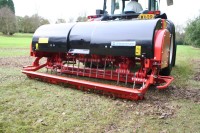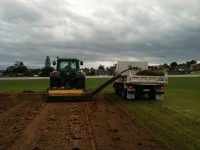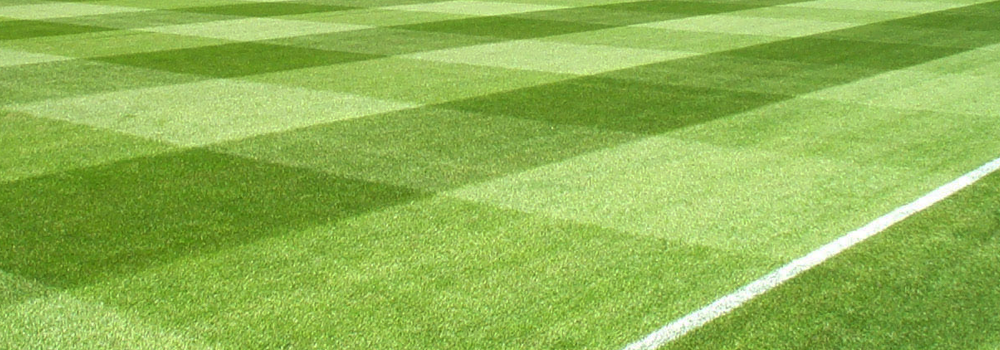Key Tasks for March
General Maintenance

If your budget allows, do some overseeding, particularly on the bare areas. This will be very beneficial in promoting grass coverage for the coming spring and will give the new grasses longer to develop. Temperatures will be getting high enough for germination or, alternatively, cover with germination sheets.
Surface levels may need to be restored in areas where scrums have occurred, by light topdressing, seeding and raking over. Infill any holes that have occurred in the pitch surface with a sand/soil and seed mix. Lightly roll after repair work, preferably with a pedestrian mower.
Keep up with the dragbrushing/matting or harrowing when conditions permit, for dew and wormcast dispersion and to help stand the grass up prior to any maintenance work. Repair divots as soon as possible after games or training, with particular attention to the scrum and line out areas.
Using a pedestrain box mower (cylinder or rotary ) will help clean and prepare the surface for matches. Maintain sward height at 25mm-75mm. The top height will cushion heavy falls on hard ground. Ensure your mowing blades are kept sharp and well adjusted. Cutting grass in very wet conditions can often be detrimental to the playing surface. The mower may smear and damage the surface, especially when turning. The quality of cut can be affected if the grass is very wet.
Repairing and replacing divots after matches is an important part of the maintenance programme to restore playing surfaces. The use of a hand fork to lift depressed turf, and gentle pressing with the foot, is the best way to return/replace divots, however, on larger areas the use of harrows will help return levels.
Marking out is done as required. Playing pitch surfaces can often become muddy and very wet, which may sometimes affect the performance of wheel to wheel transfer line marking machines. To overcome this problem, other marking systems are available. Pressure jet and dry line markers are able to produce lines on uneven and muddy surfaces. Care should be taken when initially marking out new lines, ensuring that they are true, straight and measured correctly, using the 3,4,5 method to achieve accurate angles. Always wash down the machine after use; if you are not likely to use the machine for a few days, it would be advisable to empty it. Particularly with spray jet markers, keep connections clean; spray with WD 40 to help keep it protected.
Pre and post match routines
Before the match
- Check that the pitch is fit and safe for play
- Check for debris (glass, stones etc.)
- Clear away leaves – a thankless task, but one that needs doing
- Ensure the surface is firm and not saturated, correctly marked out and flagged, and that the posts are safe and secure
Post match
- Replace divots, even if it’s just the worst affected areas - it will make a difference!
- Dragmat/brush/harrow to restore playing surfaces and remove worm casts
- Clean up the playing surface with a rotary mower
Additionally ...
- Plan ahead for end of season renovations; particularly important if you have been affected by flooding
- You could also consider booking in your machinery for its annual service/repair, ensuring you get the time slot that suits you
- Dragmat, harrow and groom rake surface, as required, to maintain levels, remove early morning dew, control disease and generally get air in and around the plant
- Spike/verticut as often as possible
Remember – the more that club members, players and officials understand what you role involves, the better. You could use any spare time to provide a members newsletter/blog detailing what problems you are experiencing (training regimes, waterlogging etc.) and to seek additional help as required.
Weekly checks:
- Check goals for loose bolts and tighten as necessary
- Check team dugouts are stable and anchored securely. Make sure that they are tidy and free from litter
- Repair and maintain fence lines
- Sweep up/vacuum fallen leaves
Renovations

The type of end of season renovation will be dictated by the condition of your pitches, however, the extent and what you can achieve will be driven by cost and the will of the club to invest in their pitches.
A typical end of season renovation will be centred around aeration (decompaction), scarification to remove thatch, open up the sward, topdress to restore levels and overseed to introduce some new grasses.
Before starting any remedial work it is vital to know how much you will need to spend on renovation, as cost can easily escalate if you fail to research prices against the standard of surface you wish to produce. From a commercial point, the cost of renovating a football pitch can range from £4k -£40k The higher costs often relate to more intensified specialist work being required such as fraise mowing and the cost of top dressing materials being used.
The application of the topdressing as the material alone can cost anything from £35 per tonne, this work alone is the most costly part of pitch renovation and, based on an application of 100 tonnes, can easily run out at three to four thousand pounds for a 6,000m2 pitch. With various options to choose from, you may decide on a high end budget if finances allow, but, at grass roots level where every penny counts, it is more likely that a low expenditure option is chosen, with much of the work done in house with borrowed or hired equipment.
It is this cost that deters most clubs from spending money on top dressings for their pitches, which is why there are so many poor sports pitches across the country. Top dressing is an important and integral part of maintaining good football and rugby pitches by restoring levels and improving surface drainage.
Whilst we have established that maintaining a rugby pitch is an all year round activity, we do have to start somewhere, so where better than at the end of a very long playing season, usually at the end of April.
The condition of your pitch will dictate what work will be required; most pitches will have lost between 50-75% grass cover during the playing season coupled with the fact that the soil profile will have become compacted. To rectify these problems, it is essential that a programme of deep aeration (100-300mm deep) is carried out, followed by fertilising, overseeding and topdressing which will help restore levels, feed and re-introduce some new grasses into the playing surface.
However you achieve it, you will need to clean out the surface and get rid of the dead organic matter that will have built up, particularly on the wings of the pitch, and the remnants of old divots etc. A tractor drawn rake followed by a box mower is probably the most traditional method and most likely within the means of most clubs and schools. You may also have use of a pick up flail mower, in which case you may find that scarifying tines can be fitted and the job will be completed in one operation.
This method can be advantageous as the scarifying tines may leave a grooved surface, ideal for ensuring oversown grass seed is buried just beneath the surface and in contact with the soil.
An operation that is becoming popular to those that can afford it (mostly Premiership clubs fall into this bracket), fraise mowing is extremely efficient at removing the top organic layer of the pitch, however, you will effectively be starting again with a newly sown surface, so your seeding rates will need to be higher.
Raising/restoring surface levels and getting rid of those compacted areas in front of the goal is everyone's obvious, but don't forget the linesman's run-up; sometimes forgotten, but easily incorporated into your programme and, whilst you're about it, the area beside the pitch that everyone stands to watch the game will need attention.
Spiking to relieve compaction and getting air back into the soil is important. If you have a spiker that will allow some heave, such as a vertidrain or Weidenmann etc., you may find this beneficial, otherwise you may do well to hire one in or employ the services of a local sports ground contractor.

There are a number of ways to achieve this, by means of tractor mounted or pedestrian dimple/sarrel roller based seeders or disc seeders. Other ways to achieve this would be through surface spiking the area, brushing and then topdressing.
Topdressing - get it ordered and ready. Choose wisely for compatibility with your current rootzone. If you employ the services of an agronomist, then he will advise you of the best topdressing for your situation. If you cannot afford to topdress, you may consider hollow coring, recycling them by breaking them up and dragmatting them back into the surface.
Raising/restoring surface levels and getting rid of those compacted areas in front of the goal is everyone's obvious, but don't forget the linesman's run-up; sometimes forgotten, but easily incorporated into your programme and, whilst you're about it, the area beside the pitch that everyone stands to watch the game will need attention.
A good pre-seeding fertiliser, low in nitrogen and high in phosphate and potash (P:K), to provide the young seedling with the essential nutrients that will be deficient in a soil washed through by winter rains.
Turf treatments - some turf treatments work well for some and there are a number of them to choose from, such as organic based micronutrients, seaweed treatments, clay flocculants, amino acids and plant growth regulators such as Primo Maxx. It can sometimes be difficult to assess the benefits of such treatments, but most managers will notice if it has been effective or not. If you are unsure, then ask you supplier for a trial amount and test it for yourself. I'm sure they would be pleased to accommodate you.
A planned programme of work involves mostly renovation, which is the repair and restoration of the playing surface back to its original state, condition or, improved upon in order to be used again.
Timing is the key to success as many operations will fail and cause more problems than benefits when carried out at the wrong time of the year. In order to achieve this all operations need to be carried out in the right methods, having the right soil & weather conditions, the ability to time the schedule of work and in the right sequence.
The main objectives of renovation which should be considered are:
1. To maintain the standard of the surface.
2. To improve the standard of the playing area.
3. Rectify and install any new drainage requirements.
Once we have removed the posts, we can proceed to reduce the amount of grass from the surface to about 10 –15mm, preferably boxing off all arising’s at this stage.
Totally scarify the surface to remove all debris, thatch and organic matter. A number of passes may be required at different depths depending on the amount of organic material that is to be removed.
All arisings should be removed from the surface before the next stage of work is started. By creating a seed bed through scarifying, overseed the playing area with a 100% Perennial rye grass (preferably with three or more cultivars) by use of machine (auto seeder) bury the seed in about 10-12mm deep to ensure good seed to soil contact.
Topdress the whole pitch with a sandy/soil rootzone of 70/30 to address your levels. Aeration can then be performed to de-compact the surface allowing the top dressing to migrate down the tine holes to help with draining the surface and improve the soil profile. Drag matting or brushing will assist in this operation. An application of a pre-seed fertiliser to speed up germination or a spring/ summer 9-7-7 could be used. A soil test should determine you N.P.K, if in doubt.
Ensure bare areas are well irrigated to establish early germination. Allow new grasses to grow to at least 2nd or third leaf stage before mowing with a sharp rotary, as a cylinder mower will most likely tear the grasses from their roots. Mow and aerate regularly throughout the summer and where possible Verti- cut to help thin and prune the sward through this period. Spray for control of pests, weed and disease and over the coming weeks your sward will thicken up and become denser providing a perfect carpet for the forthcoming season.




At the time of writing, the fast moving current of air which races high above us, known as the jet stream, is sitting lower than would be expected. As a result, the British Isles lie above its path rather than their typical position above. Consequently, this allows cold arctic air to move in from the north and east, bringing with it low temperatures. The meteorologists estimate that this pattern of weather is likely to extend into the middle of March.
Despite all the modern methods we are able to employ to regulate grass plant growth, the one thing we cannot control is the temperature. This means then tricky times for turf managers who would have been hoping for warmer air to raise soil temperatures and, in turn, stimulate recovery growth after the long winter. The good news, of course, is that disease pressure is likely to be low.
Nutrition
Managers across all disciplines will be under pressure when it comes to members and players expectation of Spring. Forcing growth in such conditions, however, is simply not feasible nor sensible. The plant and soil biology know what they need and no amount of fertiliser will force them to respond when they are not ready and warm enough.
The onset of colder weather is, of course, often accompanied by sunshine, which will provide two benefits on areas which receive direct sunlight.
Firstly, photosynthesis and, secondly, localised warming. Plants will use the combination of solar energy and localised warming from the sunlight to produce sugars and start metabolic function. However, the problem with cool air at this time of the year is two fold:
- Warming and photosynthesis happen in short lived concentrated blocks of time.
- Cold night-time temperatures mean the daily base line soil temperature drops as the soil does not build up any warming momentum.
The result is patchy and inconsistent growth. A useful analogy is to think of it rather like a cyclist trying to get up to sprinting speed as quickly as possible, when every tenth rotation of the pedals his foot slips off.
In relation to inputs, it is a time to concentrate on maximising the windows when the plant and soil biology is active, as well as assisting the plant to withstand desiccation and drought from cold winds. The means to do that is with little and often liquid or soluble applications aimed at the leaf, with the intention of maximising rapid uptake and assimilation. Tools to achieve in this outcome are:
Nitrate nitrogen – research shows it is absorbed into the leaf over 48 hours where it then resides in the spaces between cells ready and waiting to be assimilated when the plant requests it.
Humic Substances – in particular, micronised formulations containing a percentage of Fulvic Acid which acts to pull fertilisers into the plant more efficiently.
Carbon – the foundation energy source of plant and soil life; providing carbon increases utilisation efficiency of fertilisers and props up the soil food web.
Seaweed – plant stress hormones prime the plant by eliciting metabolic functions which allow it to better withstand environmental (abiotic) and pathogenic (biotic) stress.
Calcium – strengthens cell walls, creating a more resilient plant.
Micro nutrients – anyone looking to make informed decisions on their soil health will have had a full chemical analysis undertaken. Foliar applications of deficient nutrients in the tank mix will allow you to overcome a lack of supply of the soil, and provide the plant with everything it needs to maximise those concentrated blocks of light energy and warmth.
Two other important factors with regards to nutrition in a cold dry spring are:
Patience – understand what the plant needs and when; don’t be tempted to plough in nutrient that cannot be consumed. It will either leach into water courses or sit, slowly degrading, forcing a disease susceptible and mower demanding flush when conditions turn warm and wet.
Preparation – get a conventional release Ammonium sulphate based granular fertiliser on the shelf, ready to go down as soon as you see and hear the forecasters confidently predicting a consistent upturn in temperatures and available moisture. Preferably one containing a little calcium for cell division and magnesium for chlorophyll production.
Moss
March is an excellent time to treat moss; however, beware too much sulphate of iron if desiccating winds are prevalent, and most certainly hold back scarifying until strong consistent grass growth is there to repair the sward.
Aeration
As areas dry out from the winter, getting on the ground with machinery and aerating will be possible. Little and often in multiple different ways is a good mantra, but beware desiccating winds leading to too much drying of the surface; especially on poa annua dominated swards
Surfactants
March is the time to start applying polymer wetting agents, such that you have enough time for the chemistry to build up in the soil ahead of summer. Prevention is absolutely better than cure when it comes to dry patch, and planning and preparation now prevents poor surfaces later in the year.
Fairy rings
March is a good time to prevent the effects from type two fair rings in the summer. A combination of aeration, surfactants and azoxystrobin fungicide will allow water and active ingredient to move into hydrophobic regions occupied by the fungal mycelium.
Start thinking about your end of season renovations, and how you may be tackling the possibility of an extended season and the need to get onto the pitches to carry out the work. Start to build your strategy and get it down on paper. Look at what resources you will need - manpower, materials and machinery.
With reference to your machinery needs; if it's part of your inventory, drag it out, dust it off and fire it up to make sure it will work for you when you need it. If you don't have it in your inventory, but you know someone who has, a neighbouring club or school perhaps, particularly if you are on good terms with them; you may come to some arrangement to borrow it when they are not using it.
Alternatively, look at the option of hiring. There are a growing number of hire companies these days that are now specialising in the hire of sports ground equipment. With reference to your material needs, get them ordered now so that they are on hand when you need them.
You are now able to obtain the basic knowledge of how to maintain a rugby pitch ONLINE:
Our LANTRA accredited Winter Sports Pitch Maintenance Course (Rugby & Football) is now available in an online format.
Like our one day course, it is designed to provide a basic knowledge of rugby and football pitch maintenance. The course enables the Groundsman to grasp the basic needs of a winter sports surface throughout a 12 month period. As an online version, it means you can learn at your own pace and at home. The Course Manual is included as part of the online course.Included in the Course Manual, there are working diaries showing the range of tasks needed to be accomplished each month. The Course Manual is available for purchase separately.
If preferred, we are able to arrange courses to be delivered on site to groups of 6 – 10 people. Email Carol Smith for information.
Initial Sports Line Marking Course:
Tuesday 20 March 2018, Allscott, Telford TF6 5DY
Other training courses available include:
Pesticides (PA courses)
Pedestrian operated mowers
Hedgecutters
Brushcutters/strimmers
Toolbox Training
Manual Handling
On the Pitchcare website, there are a number of articles/features on rugby pitch maintenance and end of season renovations.
View the Pitchcare Rugby Section
or visit the Pitchcare Forum


